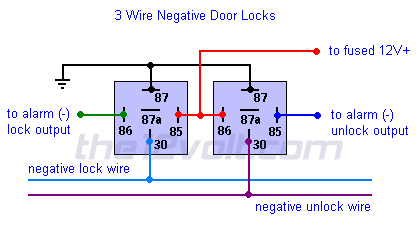

Car Security and Convenience / Power Door Locks, Multiple Wire Systems, Add Auto Lock/Unlock
Once you have determined which type of door lock switch you are working with, adding keyless entry and other locking features is very simple.
Multiple Wire Systems:
• 3 Wire Positive Door Locks (Type A)
• 3 Wire Negative Door Locks (Type B)
• 4 Wire Reversal Door Locks
• 5 Wire Alternating 12V+ Door Locks (Type C)
• Actuators / Reverse Polarity (Type D)
• Vacuum Type Door Locks (Type E)
• 3 Wire Positive Door Locks (Type A)
• 3 Wire Negative Door Locks (Type B)
• 4 Wire Reversal Door Locks
• 5 Wire Alternating 12V+ Door Locks (Type C)
• Actuators / Reverse Polarity (Type D)
• Vacuum Type Door Locks (Type E)
Add Auto Lock/Unlock:
• Auto Lock w/o an Alarm/Keyless Entry
• Auto Unlock w/o an Alarm/Keyless Entry
• Auto Lock w/o an Alarm/Keyless Entry
• Auto Unlock w/o an Alarm/Keyless Entry
3 Wire Positive Door Locks Relay Diagram (Type A)
|
3 Wire Negative Door Locks Relay Diagram (Type B)
|
4 Wire Reversal Door Locks Relay Diagram
5 Wire Alternating 12 Volts Positive Door Locks Relay Diagram (Type C)
|
Actuators / Reverse Polarity Relay Diagram (Type D)
|
Vacuum Type Door Locks Relay Diagram (Type E)
|
Add Auto Lock without an Alarm or Keyless Entry System Relay Diagram
|
Add Auto Unlock without an Alarm or Keyless Entry System Relay Diagram
|
Door Locks:
• Determining Switch Types
• Multiple Wire Systems
• Add Auto Lock/Unlock
• Single Wire Systems
• Special Systems
• Determining Switch Types
• Multiple Wire Systems
• Add Auto Lock/Unlock
• Single Wire Systems
• Special Systems
Car Security and Convenience:
• Basic Connections (inputs)
• Basic Connections (outputs)
• Car Alarm Modules
• Car Alarm Sensors / Triggers
• Door Locks
• Light Flash / Illuminated Entry
• Starter Interrupts
• Accessories & Add-ons
• Basic Connections (inputs)
• Basic Connections (outputs)
• Car Alarm Modules
• Car Alarm Sensors / Triggers
• Door Locks
• Light Flash / Illuminated Entry
• Starter Interrupts
• Accessories & Add-ons
Relays and Relay Wiring Diagrams:
• SPDT and SPST Relays
• Converting Polarity
• Door Locks
• Illuminated Entry & Light Flash
• Special Applications
• Starter Interrupts
• Relay Diagrams - Quick Reference
• Relay Forum
• SPDT and SPST Relays
• Converting Polarity
• Door Locks
• Illuminated Entry & Light Flash
• Special Applications
• Starter Interrupts
• Relay Diagrams - Quick Reference
• Relay Forum

| Search the12volt.com |
Follow the12volt.com 
Friday, December 19, 2025 • Copyright © 1999-2025 the12volt.com, All Rights Reserved • Privacy Policy & Use of Cookies


Friday, December 19, 2025 • Copyright © 1999-2025 the12volt.com, All Rights Reserved • Privacy Policy & Use of Cookies
Disclaimer:
*All information on this site ( the12volt.com ) is provided "as is" without any warranty of any kind, either expressed or implied, including but not limited to fitness for a particular use. Any user assumes the entire risk as to the accuracy and use of this information. Please
verify all wire colors and diagrams before applying any information.












